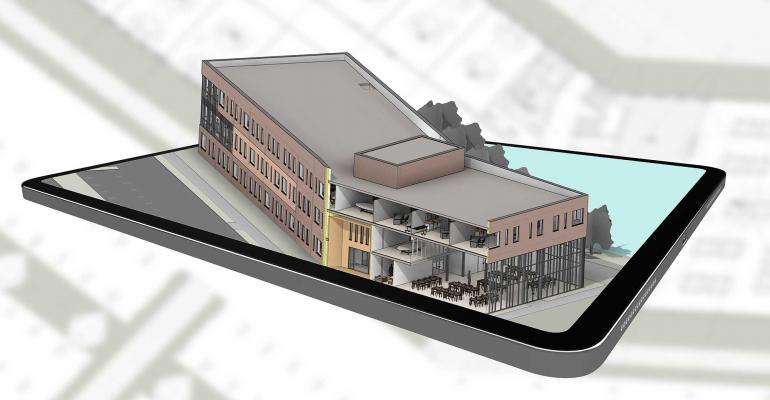Virtual tours are becoming much more prevalent in the leasing process, especially due to the pandemic. But there are certain aspects of commercial space that only in-person tours can provide an accurate feeling for.
“A virtual tour is never a replacement to putting boots on the ground. You’re always going to have a better feel for the building, the site, the location, the logistics of everything by physically being there,” says Jason Wurtz, executive vice president, office division, with real estate services provider NAI Hiffman. “Virtual tours I don’t believe will ever be a complete replacement for physical tours.”
For instance, one thing that virtual tours don’t account for is the sound of a space. Some tenants may be put off by the noise coming off the street or a local train passing by that may not be evident during a virtual tour, says Paul Gaines, managing director of asset management for Accesso, owner of office properties. Second, virtual tours cannot give an accurate representation of the rest of the tenants in a building, or the social aspect of the building, according Gaines.
Other aspects that a virtual tour might miss that prospective tenants should make sure to focus on include gaining a true feel for the available amenities and the neighborhood, says Brandon Forde, president of client solutions at real estate services firm CBRE. Certain aspects of the in-person experience, such as access to daylight and the depth of a space, also can't be fully experienced through a virtual tour, says Paul Teti, senior vice president at Columbia Property Trust.
“The video can show you the inside and give you some good visuals, but it can’t necessarily give you a hands-on feel for the area,” says Gaines. “If the space seems to work and everything seems to meet the requirements, then you need to check out the area and see if the rest of it all fits together for you.”
Prospective tenants should have a defined list of criteria for their space to avoid wasting time on properties that don’t meet their needs, says Forde. For example, access to transit, parking, on-site amenities and location can all be filtered ahead of time in order to save time on touring properties. Tenants should treat the virtual tour as if they were still touring in a normal fashion, according to Gaines. That means checking parking ratios, accessibility to parking garages, age of the building, ownership of the building and quality of the asset.
“These are major financial obligations that tenants are signing up for, and to me, there is still a see, feel and touch part of that decision in signing up for a long-term financial obligation,” says Adam Showalter, managing director at Stream Realty, a commercial real estate agency. “I haven’t seen yet a virtual tour replace an actual physical tour to get to an executed lease. What we have seen is [potential tenants] eliminating some initial tours. But at the end of the day, I do still think tenants, if they are signing up for an obligation of this size and magnitude, that they want to see, feel and touch a building.”
Potential tenants should use virtual tours to narrow down their options and get a better feeling of the whole building, not just focus on the floor they plan to lease. This should include previewing the building lobby, elevator areas and other amenities, says Scott Harper, senior vice president and managing director with real estate services firm Colliers International.
“You can’t just say, ‘Okay, you’re interested in suite 625, here’s the virtual tour of suite 625.’ In that vacuum, I don’t think it works,” says Gaines. “So, if I’m entering from a parking garage, give me the ability to virtually walk in through the parking garage into the lobby, into the elevator lobby, and the elevator lobby of the floor I’m getting off [at]. I think you almost have to try to re-create the experience of what it is like to come to work every day. That’s the challenge, having to create that entire coming to work experience.”
Office tenants should consider how they will fit out the space, as the virtual technology allows for this customization. Providing an experience that is as similar as possible to a physical walk-through is what keeps a prospective tenant interested, says Teti.
With the interactive technology, viewers can change the layout of entire floors, as well as visualize the surrounding view and cityscape, says Tahirah Mahan-Thomas, managing director of location intelligence and retail analytics with CBRE. The most sophisticated programs allow for the adjustment of dimensions to fit out the space for a specific tenant, which is particularly useful for tenants with unique space requirements, such as creative studios and life sciences offices.
In a soft office market, a tenant may choose to tour around 20 properties before making a decision. Now, they can do a lot of the elimination just through the virtual tours and come down to three to five properties they think are a best fit for them and only tour those in-person, says Harper. Prospective tenants based in other markets can also tour office spaces using virtual tours without having to travel across the country, says Teti.
“Our virtual tours are designed to help clients pre-tour the market. Being able to explore options and winnow down to a short list before seeing sites in person is not only critical in times of social distancing, it just makes sense that we would leverage technology to be more efficient with our client’s time,” says Mahan-Thomas.





